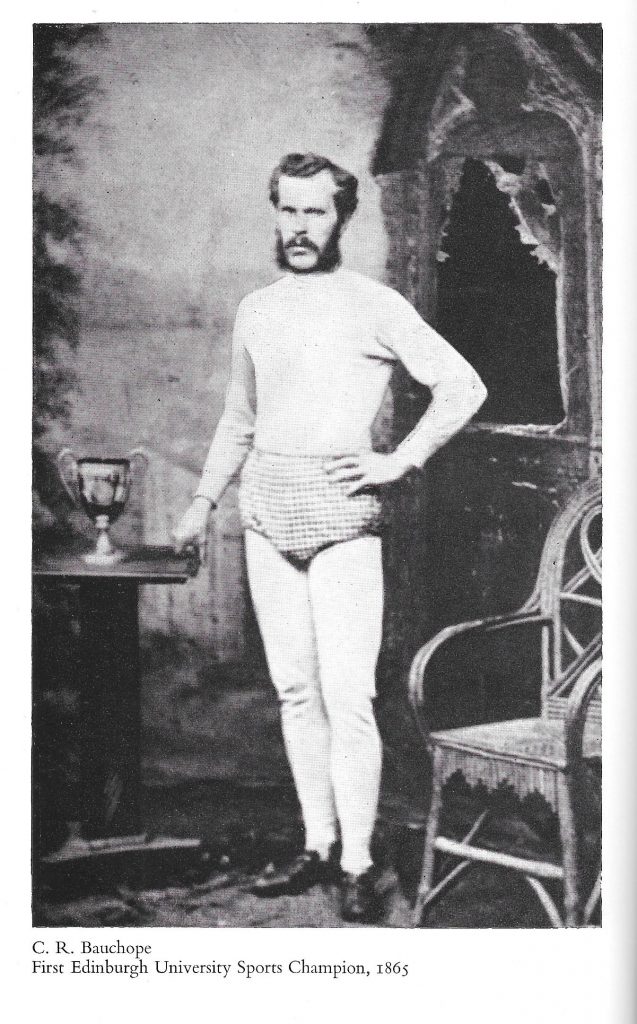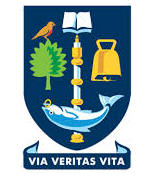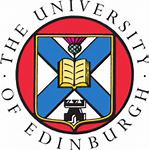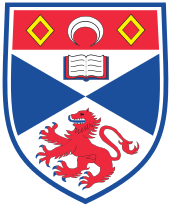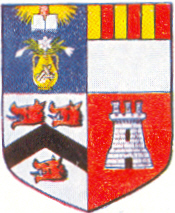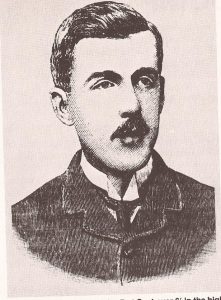There was a widely held belief, even among most of the Scottish athletics historians, that after the Inter-Universities Sports held in 1871, 1872 and 1873, the event fell into abeyance until 1879. However it appears that this was not the case. “The Story of Edinburgh University Athletic Club”, published in 1966 has a chapter on athletics by Dr Neil Campbell in which he says that the event was actually contested – apart from a hiatus in 1874 – up to 1879 and it was at that point that the gap appeared. On investigation this was shown to be the case. This is what we are looking at – the missing years in the Inter-Universities Sports.
The Scotsman of 15th March, 1875, reported on the Edinburgh University Sports (‘the eighth annual’) saying that the object of the meeting was to help the committee select their representatives for the forthcoming inter-universities championships. One week later and it was the turn of St Andrews University to hold their own trials ‘in a field adjacent to the railway station’ which, being flat and covered with a short herbage was suitable for the purpose and they came away hopeful of winning some medals at the championships the following week. The inter-universities was held on 27th March and reported the following Monday. The Scotsman report on the Monday began –
“The periodical trial of strength and skill by representative athletes of the Scottish Universities, which in student circles is a pleasant indication of the close of the winter session, took place on Saturday afternoon in the grounds of the Edinburgh Grange cricket club in Raeburn Place. On this occasion, the usual number of selected put in appearance, with the exception of the contingent from the Aberdeen University, but as the absence of these representatives had been anticipated, there was no upsetting of the previous arrangements through their failure to come to the front. Last year, it may be stated, they were to take place at Aberdeen, but owing to various circumstances the competition was not carried through, and not only was the meeting then allowed to remain in abeyance for the year, but the students of the Northern University have failed this season to take the necessary steps to getting a team forward. The success, however, with which the programme was got through fell in no way short of that of former years.”
In the competition there was agreement that the top performances were those of C Kilner in the 880 yards (won by half a yard in 2:15.4) and JM Cotterill in Thorwing the Cricket Ball (won with 121 yards, 1 foot 4 inches.). Edinburgh won the tea race comfortably.
March 18th, 1876, was the date for the St Andrews Sports and Trials which were held on a track near the railway station. The programme included golf (won by W Proudfoot with 92 strokes against TD Millar and A Mackinnon=105 strokes; and golf, longest drive. Won by Proudfoot with 103 yards). The Edinburgh Sports and Trials for theinter-universities championships were held the following Saturday at Powderhall. The actual sports themselves were held on 1st April and The Scotsman report read:
“The annual sports of the Scottish Universities were held with great success on the grounds belonging to the West of Scotland Cricket Club on Saturday afternoon. The band of the 13th Light Infantry were present and there was a large and brilliant attendance of spectators, who were favoured with splendid weather. The sports commenced shortly after two pm. The quarter mile was easily won by McKenzie. In the 100 yards flat race Thomson had hard work to breast the tape before Johnson, both appearing to be in rare form. In the half mile race a good start was made but eventually McKenzie of St Andrews shot out in front of the others and won a grand race. The mile race, as usual, caused great excitement. The other events were on the whole keenly contested.”
The events contested included 100 yards (Thomson G), Quarter Mile (McKenzie G), Half Mile (McKenzie St A), Mile (Kilner E), Hurdle Race (Peterkin G), Hop, Step and Jump (Boucher E), Long Leap (Brunton G), Pole Vaulting (Rutherford E), High Jump (Smith E), Throwing the Hammer (Irvine E), Putting the Cannon Ball (Wilson G), Throwing the Cricket Ball (Dickson G). The Glasgow Herald tells us that the fields were small in several instances but the competition was keen.
It was on the last Saturday in 1977 March that the Inter-Universities match took place. The Scotsman tells is that Glasgow took most of the honours on this occasion. The results:
100 yards: R Williamson G; Quarter Mile: E Woodhead E; Half Mile: R Paterson G; Mile: R Paterson G; Hurdles: A Peterkin G; Hop, Step and Jump: L Richards St A; Long Leap: HB McMaster E; Vaulting with the Pole: G McPherson G; High Leap: JVW Rutherford E; Throwing the Cricket Ball: J O’Reilly E; Putting the Stone: J Wilson G. Six wins for Glasgow, Four for Edinburgh and one for St Andrews. The only double was in the half- and one mile, L Richards won the hop, step and jump and had seconds in the long leap and pole vault while McMaster won the long leap and was second in the hurdles.
In 1878, the championships were held on 16th March and the report in the Scotsman the next Monday was a full one. It read as follows:
SUCCESS OF THE EDINBURGH UNIVERSITY TEAM
The Scottish Inter-University Sports were held on a fine stretch of lawn in front of the Partick Burgh Hall on Saturday afternoon, and although the weather was very dull, there was a numerous attendance of spectators, including a great many ladies. During the seven years which have elapsed since these athletic displays were instituted they have continued to attract a considerable amount of attention, not only in academic circles but amongst the general public and they have invariably attended with a gratifying measure of success. On the present occasion the honours were fought for by teams from Edinburgh, Glasgow and St Andrews, the only college being unrepresented being Aberdeen. The hour fixed for the commencement of the sports was two o’clock but it was much later before the first of the competitors entered the field. When the officials – who comprised Mr Wm Cross, judge; Mr AW Evans, timekeeper; Mr R Henderson, starter; Mr CW Cathcart (E), Mr JB Brown (G) Mr AA Adie (St A) race committee – and the stewards made their appearance they were greeted with great cheers. The whole of the prizes for the first event on the card – hop, step and jump – for which there were six entrants, went to the Edinburgh team for GS Woodhead was first with 40 feet, while WSS Reid ranked second with only two inches less. In throwing the 18 lb hammer, the second event, the Glasgow team came to the front, as Neil McDonald scored 56 feet 9 1/2 ins, being 2 feet 7 1/2 inches above the figures reached by HH Johnston, the Edinburgh champion. In the quarter mile race E Woodhead reached the goal in 57 4-5th seconds, about a foot ahead of WW Beveridge, the representative of the Western team. On the finish of the long leaping, which was the fourth event, the two Edinburgh competitors were found to have left the other three far behind, JBS Greathead having registered 19 feet 5 1/2 ins and CS Woodhead 15 feet 10 1/2 ins. The Glasgow team re-appeared as victors in the fifth event – the 100 yards flat race for which five entered, as R Williamson covered the distance in 12 3-5th seconds ahead of E Woodhead who represented the Edinburgh team. In the pole-vaulting, G MacPherson,(Glasgow) was first with 9 feet. The half mile flat race – for which there were five entrants – was secured to the Edinburgh team with all the honours, as RJS Henderson completed the distance in 2 mins 15 sec, while J O’Reilly was not more than a second later. It had been arranged to run the hurdle race in three heats, and in the first of these H Moncrieff of the Glasgow team gained the chief position; while in the second J Montgomerie of the Edinburgh team was the winner. The deciding heat was won by J Montgomerie after a sharp contest. In the high jump the Edinburgh team outstripped all the other competitors, WSS Reid being first with 5 feet 5 ins and EH Hummel second with 5 feet 3 ins. The principal award was also secured to the Edinburgh team in putting the 16 lb cannon ball by HH Johnston with 34 feet 3 ins which was two inches before WCC McDonald of the Glasgow team. In throwing the cricket ball, the eleventh event, the Edinburgh team once again gained both prizes as J O’Reilly was first with 94 yards and EH Hummel second with 10 yards less. The twelfth and last event was possibly the most important, being the one mile race but only three of the six intending competitors entered the lists – RJS Henderson and Simpson of the Edinburgh team and P Hutchison of the Glasgow team. On the pistol being fired, Hutchison shot ahead and maintained the lead for some time, but he was passed by Henderson when about half the distance had been accomplished and he ultimately retired.The race was continued with great spirit by the two Edinburgh representatives but when the goal was reached Henderson still held the leading position though only a few steps in front of Simpson, the time of the winner being 5 min 9 4-5th secs. Of the prizes which consisted of 12 silver and 12 bronze medals, exactly three fourths were secured by the Edinburgh team who not only won the whole of the honours in one half of the twelve events, but obtained besides three first and three second prizes. The remaining third of the prizes went to the Glasgow team, and the St Andrews team failed to take any of the honours.”
The fact that there were only two medals awarded for every event is highlighted in the above report as is the fact that there was no gold on offer! In any sense of the word – they were amateurs, insofar as any sportsman of the time was an amateur by present standard – so no coin was involved and there were only silver and bronze medals. Note that the Edinburgh team contained two Woodheads and one Greathead.
In 1879 the Sports, referred to in the Glasgow Herald headline as the Inter-University Games, were held on 22nd March. The report in that paper read: The Scottish Inter-University Sports took place on Saturday at St Andrews and drew together a good field, all the universities being represented, excepting Aberdeen. The great portion of the prizes were carried off by Edinburgh, the local university being next. The weather was particularly favourable and the path in good order. Dr JW Moir acted as judge, Dr Burns Murdoch timekeeper and Mr R Henderson starter. There were in all fourteen events which were contested with much spirit. The following is the prize list:
100 yards flat race: 1st JW Parsons (E) 10 3-5th secs; 2nd WW Beveridge (G).
Long Leap: 1st GA Russell (St A) 19′ 9″; 2nd EH Barclay (St A);
Throwing the Hammer: 1st HH Johnston *E) 85′ 5″; 2nd E Morrison (St A);
Quarter Mile Race: 1st WW Beveridge (G) 58 1/2 sec; 2nd GA Russell (St A);
Putting the common ball: 1st WG Duncan (St A) 35 1/2 feet; 2nd JF Cameron (St A);
Pole Vaulting: 1st J Thomson (E) 8′ 6″; 2nd JSS Reid (E);
Half Mile Flat: 1st AS Paterson (E) 2 min 11 sec; 2nd GA Russell (St A);
Hurdle Race: 1st JW Parsons (E); 2nd E Clegg (E);
Hop, Step and Leap: JW Parsons (E) 51′ 5″; 2nd JF Cameron (St A);
High Jump: 1st JSS Reid (E) 5′ 4″; 2nd JW Parsons (E);
Throwing the Cricket Ball: J O’Reilly (E) 113 yards 3 feet; 2nd JF Cameron (St A);
One Mile Flat Race: 1st AS Paterson (E); 2nd DM Moir (St A);
Golf Competition: 1st JF Cameron (St A) 91 strokes; 2nd FW Marshall (E).
The only venue that ever had a Golf Competition as part of their own annual sports, also had it as part of the inter varsity sports, and that venue was St Andrews. And they won it. Note the versatility of some of the competitors – JW Parsons (pictured below) who had 4 first places, went on to become a Scottish champion long jumper and record setter.
This time the sports really did go into abeyance but the ‘Glasgow Herald’ of 20th March, 1899 has a report on the meeting to re-introduce the inter-university champs. Ir is reproduced here as it gives an insight into what prompted the move and what it was hoped would be gained from it.
“If we except football, athletic life at our Scottish universities is not as healthy as it might be; indeed, there was ,ore activity and more genuine interest in general athletics at Edinburgh, Glasgow and St Andrews ten years ago than there is now. It is common to represent these centres of intellectual light as given up almost wholly to the worship of athleticism, but it is scarcely necessary to say that this is a delusion. Athletics have a fairly reasonable hold at Edinburgh but it might easily be stronger and more general without interfering in any way with the intellectual development of the students. This is evidently being felt, as a proposal, emanating from the capital, is on foot to establish inter-university sports, and a meeting of delegates from Edinburgh, Glasgow, St Andrews and Aberdeen is to be held shortly at Dundee to discuss the scheme, and, if at all possible, bring off a gathering this season. Glasgow students seem to think the idea will take practical shape, as on Friday several confined races were decided at Hampden Park. and though the performances were not of much account, there was enough merit to justify the expectation of better things. We may mention that many years ago, inter-varsity sports were held under the auspices of the Edinburgh University AC, but for some reason or other the event lost its charm, and was eventually dropped altogether. We hope the contemplated scheme will be carried through as the commonplace character of athletics at our universities is not only a reproach to those institutions as centres of intellectual and physical activity, but it is also a reproach on the prestige which we as a nation enjoy for athletic achievement.”
